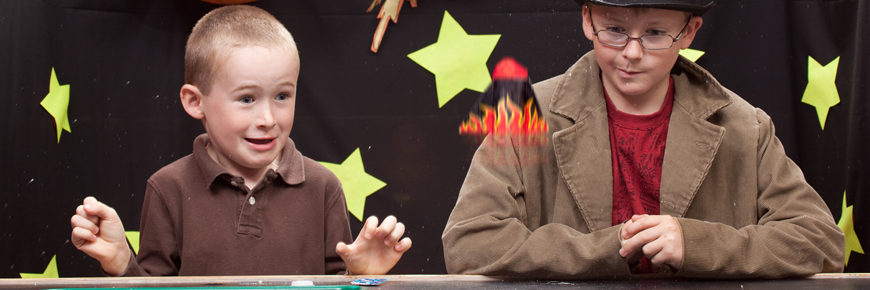
Experiments
Alexander Graham Bell National Historic Site
Can water go uphill? Find out in our experiment program, taking place in the Discover area, an accessible, high-ceilinged open space inspired by Bell’s experiments with kites. Help us perform simple experiments like those Dr. Bell did with his grandchildren!
July 1 to August 30
Daily
10:30
20 minutes
Free
Bell's after dinner experiments - try this at home!
Simple experiments can lead to new discoveries about the world around us, and through experiments, basic scientific principles can be understood more readily. We observe a phenomenon and seek to discover why it occurs.
As an enthusiastic proponent of the Montessori method of teaching, Alexander Graham Bell felt that the concept of learning by doing was a most important one. And as a teacher, and as a father and grandfather, he came to spend a great deal of time with children. He did not think that children should have general principles of science explained to them and then accepted upon authority. He was devoted to providing the means through which children could learn to reason for themselves.
It is recommended, of course, that the parent, teacher or assisting adult do those parts of the experiments which involve the use of matches or hot water, while the children observe. Enjoy!
Inverted glass of water
Materials:
1 drinking tumbler, glass or plastic.
1 piece of construction or blotter paper (at least ½ in. bigger than diameter of glass)
Enough water to fill glass
Empty container (e.g. dishpan)
Method:
Fill glass of water to brim. Place paper over mouth of tumbler. Hold paper in place with hand and turn glass upside-down quickly. Remove hand holding paper.
Desired Results:
Paper will remain in place and water will remain in inverted glass.
Scientific Principle:
At sea level the atmospheric pressure is 101.3 Kilopascals (Newtons per meter squared) or 14.7 lbs/in2. This pressure is felt in all directions and on everything. In this experiment, when the glass is filled with water, the air is replaced by the water. Since there are only about 200 grams or about ½ lb of pressure exerted by the water inside the glass, the atmospheric pressure outside the glass is much greater and therefore the paper remains in place. (14.7 - 0.5 lbs equals 14.2 lbs pressure on paper).
Bell Connection:
Bell recorded this experiment in Beinn Bhreagh Recorder on Jan. 19, 1912, as being shown to Mrs. Bell and Mr. and Mrs. Fairchild.
Presentation Suggestions:
Perform experiment over a container to avoid spilling water everywhere.
Egg into the bottle
Materials:
One peeled hard-boiled egg.
One narrow-necked glass milk bottle
Scrap of paper
Matches
Method:
Light scrap of paper and drop into bottle. Before fire goes out set egg firmly on top of bottle.
Desired Results:
Fire goes out and egg will be sucked into bottle with loud pop.
Simple Explanation:
The fire burns up the oxygen inside the bottle, creating less air pressure inside than outside. The greater air pressure outside the bottle forces the egg into the bottle.
Scientific Principle:
When a gas is heated its volume increases (Charles' Law, Ideal Gas Law). When the egg is placed on top of the bottle, sealing the bottle, the fire consumes all the oxygen and goes out. Thus the temperature in the bottle decreases, reducing the pressure (Boyle's Law) and creating a vacuum. Also the air pressure outside the bottle (101.3 kilopascals or 14.7 lbs/in2) helps to force the egg into the bottle.
Bell Connection:
In the movie "Dr. Bell at Baddeck", Bell's daughter, Elsie Grosvenor, talks about her father having shown this experiment to her.
Presentation Suggestions:
Not recommended for child participation because of fire but child may place egg on top of bottle. Bottle must be dry inside. Egg must be placed on bottle before fire goes out.
Your own propeller!
Ask an adult to help you make this at home. You will need a 12 cm (5 in) square piece of paper, a pin, a pencil with an eraser, scissors, and a ruler. Draw an X on the paper, from corner to corner (with the ruler) to find the centre. Then...
1. Cut in at each corner, but not all the way.
2. Fold up every other corner and glue to the centre.
3. Pin the centre of the propeller to the side of the pencil eraser.
4. Now for some fun! Hold your propeller up and RUN!
Stump your friends!
Lay six toothpicks and three green peas (or three bits of wax–anything you can stick the toothpicks into) on a table. Ask your friends to make four triangles with them. (No, they can't break the toothpicks!). When they give up, take three toothpicks and three peas, and sticking each end of each toothpick into a pea, make a triangle. Lay it on the table. Now take the other three toothpicks and balance them tee-pee style on the first triangle by sticking each bottom end in a pea and leaning the top ends together. You have made a tetrahedron and, as you know, it's made of four triangles!
Old fashioned tin can telephone
Have you ever made an old fashioned tin can telephone? If not, why not give it a try? All you need are two empty cans, (soup cans are a good size) and a long piece of string. Four metres (12 feet) or longer would be fine. Have an adult help you punch a hole in the centre of the bottom of each can. Put the ends of the string through the holes and make a knot in both ends so that the string won't pull out. If you are using fishing line, knots won't be big enough, so tie a twig or piece of cloth in the ends so they won't come out. Now give one can to a friend, take the other and walk away from each other until the string is tight. Take turns listening and talking. It really works!
- Date modified :